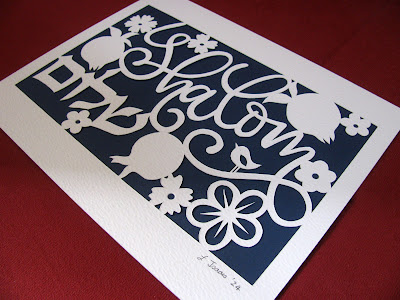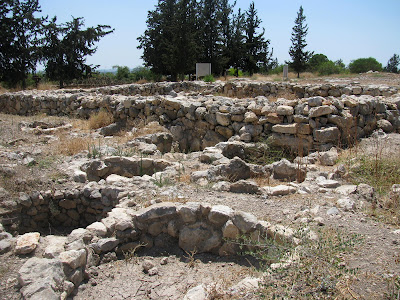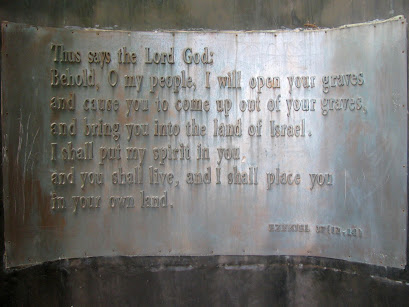Regular readers will remember that we lost our son in May 2022. He was 19 years old. We are still trying to get to the bottom of what happened to him the night he died, and the war in Israel has not helped the situation. I am writing this post because I want everyone to remember Gadi. Showing you his brick at the memorial is just one way to remember him.
Israel's National Memorial Hall for Fallen Soldiers is located on Mount Herzl, where Israel's national military cemetery and other memorial and educational facilities are situated. It is a memorial for all servicepeople - from the army, police, Shin Bet security agency, Mossad spy agency and prison service - who gave their lives establishing and defending the State of Israel, and includes not only those killed in action, but also anybody who died in uniform. Planning and building the site took more than 10 years. Construction on the memorial began in March 2015 and the hall was finally opened to the public on the eve of Israel's Memorial Day, Yom HaZikaron, in April 2017. It is the first memorial in Israel that commemorates the memory of all Israel's fallen soldiers in one site. There are hundreds of other monuments for individuals or particular battles or military corps scattered across the country, many of which I have written about previously.
Gadi Isaacs
19th January 2003-21st May 2022
The exterior of the hall, which is set alongside a busy street in Jerusalem, echoes the topography of the surrounding mountain landscape, while inside a tall torch-like formation of bricks, symbolizing an eternal flame, opens the hall to the sky, flooding the void with natural light. At the entrance, a video installation by Israeli artist Michal Rovner juxtaposes groups of soldiers from various periods in the history of Israel's wars, moving and running on one shared landscape before fading away.
More than 24,000 bricks wrap around the hall's walls, forming a 250-metre long "Wall of Names". Each brick is individually engraved in the same font and size with the name of a fallen soldier and the date the soldier died. Neither rank nor mention of the place or circumstance in which the soldier perished is listed. The bricks are no higher than about six feet from the floor, so that family members can reach up and touch the name. A lightbulb adjacent to each engraved brick is lit on the anniversary of the soldier's death, as per the Jewish tradition to light a candle so that the memory of lost loved one still lives on and burns bright. Every morning a memorial service is held in order to honour those who fell on that specific Hebrew date, and near the hall's upper exit, twelve pillars with screens display the pictures and more information about the men and women who died on that day.
The "Wall of Names" begins with the most recent fatality, and at the top of the spiral is a brick with the name of the Jewish guard who was killed in Jerusalem in May 1873 as part of a dispute with the Palestinians over water in the years before Israel became a state. The names - which sadly now also include two of Gadi's closest friends, Ariel and Yakir, who both fell in Gaza - are inscribed in local stone.Visitors are led through the memorial, from the external entrance court, past the Ner Tamid (eternal flame) and a flag pole with the Israeli flag, through the main spiral ramp and ending at an upper exit, from which one can continue into the military cemetery. A computerized system enables visitors to access information, pictures, and summarized biographies of the dead via touch screens. Towards the end of the journey through the hall, visitors are invited to light a virtual candle in memory of a particular soldier.
Israel's National Memorial Hall for Fallen Soldiers was included on the list of finalists for the prestigious Royal Institute of British Architects' 2018 international prize for world's best new building. The memorial was designed and constructed by Kimmel Eshkolot Architects, a Tel Aviv based Israeli architecture firm.
Finally, a happy update regarding the hostages. After 477 days in captivity Na'ama Levy, Karina Ariev, Daniella Gilboa and Liri Albag returned to Israel yesterday as part of a ceasefire deal with Hamas. Last week Emily Damari, Romi Gonen and Doron Steinbrecher were released. No words can describe the relief. But the price Israel has had to pay for their release is painfully high - amongst the prisoners released are mass murderers.
But to Na'ama, Karina, Daniella and Liri - welcome home!
90 hostages remain in captivity in Gaza. Bring them home now!
* This post has been shared on The Good. The Random. The Fun., Wordless Wednesday (on Tuesday) and My Corner of the World.







.jpg)







.png)































































